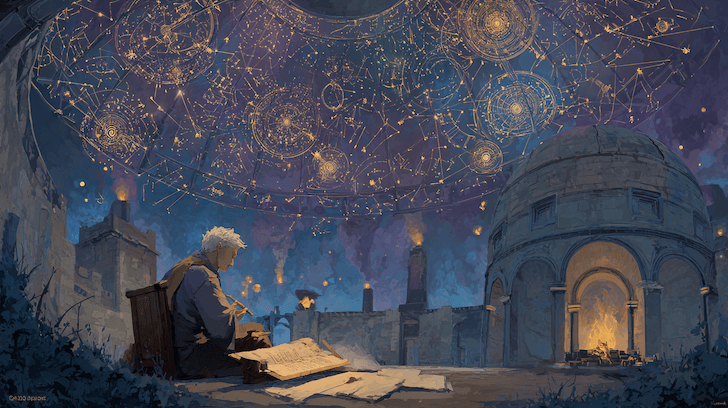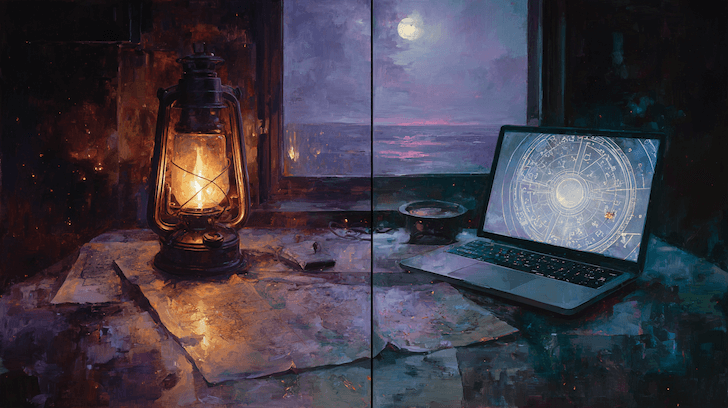The Revival of Astrology in the 20th Century

Astrology didn’t vanish; it lost institutional backing. By the 1700s–1800s, universities across Europe separated astronomy from astrology, dropped astrological coursework, and redefined “proper” science. Practice retreated to almanacs, court remnants, healer lineages, and private study. The 20th century brought it roaring back—first via print and psychology, then via software and the internet—reshaping both method and audience.
The modern revival is a story of media (almanacs → newspapers → books → forums → podcasts → apps), method (psychology + recovered tradition), and tooling (ephemerides → PCs → online charts).
Before the Revival — Why Astrology Faded
| Century | Pressure | Effect on Astrology |
|---|---|---|
| 17th | Scientific revolution and professional astronomy | Methods split; astrology framed as untestable or folk practice |
| 18th | Enlightenment skepticism and curriculum reform | Universities drop astrology; public practice narrows to almanacs |
| 19th | Industrial modernity and secularization | Astrology survives in popular prints and esoteric circles, not in academia |
The 20th Century Return
| Wave | What Shifted | Key Notes |
|---|---|---|
| Print popularization | Horoscopes in newspapers and magazines | Sun-sign columns make astrology daily and accessible |
| Psychological turn | From prediction to personality and meaning | Alan Leo, Dane Rudhyar, Liz Greene recast language and ethics |
| Outer planets mainstreamed | Uranus, Neptune, Pluto deepen archetypes | Long cycles = generational and transformative readings |
| Software era | Instant charts, accurate timing, visual tools | From log tables to Solar Fire, astro.com, Swiss Ephemeris |
| Internet culture | Forums, blogs, podcasts, social media, apps | Community learning, niche methods, global adoption |
| Source-text revival | Retranslation of Greek/Latin/Arabic corpora | Sect, lots, profections, whole-sign houses re-enter practice |
Milestones and Movers
- Alan Leo reframes delineation around character and ethics, catalyzing natal focus and popular handbooks.
- Newspaper horoscopes introduce millions to zodiac language; the Sun-sign becomes a cultural gateway.
- Dane Rudhyar develops humanistic, process-centered readings—charts as cycles of growth, not verdicts.
- Midcentury schools like Cosmobiology emphasize midpoints and measurable signatures.
- Liz Greene and the depth-psychology wave integrate Jungian concepts and relational dynamics.
- Jim Lewis launches modern astrocartography—planet lines across maps for relocation insight.
- Project Hindsight and allied scholars retranslate ancient texts, restoring techniques like sect, profections, and releasing.
Tools that Changed the Craft
| Tool | What It Enabled | Why It Mattered |
|---|---|---|
| Ephemerides to software | Instant positions, house systems, returns, directions | Precision and speed—more time for interpretation |
| Swiss Ephemeris and NASA data | High-accuracy calculations and time conversions | Confidence in timing windows and rectification |
| Chart programs and online services | Multi-chart overlays, synastry, composites, relocations | Complex techniques now routine in consults |
| Astrocartography engines | Angular lines, parans, local space maps | Relocation and travel readings for non-specialists |
| Asteroid catalogs | Ceres, Pallas, Juno, Vesta, Chiron, thousands more | Fine-grain thematic nuance without manual tables |
| Databases and research groups | Curated birth data, rating systems, query tools | Better study design and pattern testing |
Software didn’t just save time—it expanded technique. Solar and lunar returns, profections, primary/secondary progressions, time-lords, midpoints, and relocation became accessible to everyday practitioners.
How Practice Evolved
- Tone and ethics: Less judgment and fatalism; more collaboration, client consent, and trauma-aware language.
- Scope: From monarchs and elections to individuals, couples, teams, and creative planning.
- Method blend: Psychological framing layered with revived traditional timing—sect, lots, profections, and releasing alongside transits and returns.
- Education: Books, schools, conferences, and online cohorts create shared standards and peer review.
The Internet Effect
| Channel | Impact on Astrology | Upside / Downside |
|---|---|---|
| Forums and blogs | Technique sharing, long-form debate, archives | Collective learning / uneven quality control |
| Podcasts and video | Interviews, history, live chart work | Accessible teaching / variable sourcing |
| Social media | Memes, rapid diffusion of concepts | Mass reach / oversimplification and hot takes |
| Apps and APIs | Personalized timing, notifications, education | Daily engagement / dependency on defaults and orbs |
| Online maps and tools | Relocation, synastry, electional planners | Do-it-yourself exploration / need for context and ethics |
Why the Revival Stuck
Astrology thrives when it speaks to lived experience. The revival aligned with therapeutic culture, self-tracking, and digital community. People wanted language for pattern, timelines for change, and permission to choose—and modern astrology delivered that blend.
- It became practical: timing, planning, reflection—not just prediction.
- It became personal: psyche-forward, consent-based, growth-oriented.
- It became provable-to-self: people could track cycles and compare notes publicly.
Current Frontier
- Ongoing integration of traditional techniques with modern counseling skills.
- Better data standards for birth times and research claims.
- More careful ethics around health, finances, and consent in readings.
- Richer cross-cultural literacy—respecting Jyotiṣa, Chinese systems, and other lineages on their own terms.
The revival wasn’t a single event; it’s a century-long recombination of media, method, and community. From newsstands to smartphones, from character sketches to source-text timing, astrology re-entered public life with new tools and a new voice—less decree, more dialogue.
History of Astrology

Ancient Astrology vs. Modern Astrology

Get Your Birth Chart
Calculate your complete astrological chart with precise astronomical data based on your birth time and location
Generate Chart